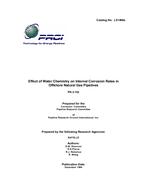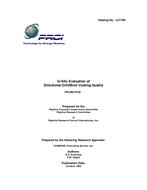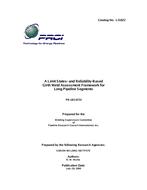Provide PDF Format
PRCI PR-15-148
- BRINE STRING INTEGRITY SURVEY AND MODEL EVALUATION
- Report / Survey by Pipeline Research Council International, 09/15/2008
- Publisher: PRCI
$6.00$12.00
L52293e
0
Need: Brine strings are essential components of both natural gas and liquid hydrocarbon storage caverns. Both the natural gas and liquid hydrocarbon storage industries are well aware that a limit exists for the fluid velocity in the injection tubulars in their storage caverns. If the brine injection or brine withdrawal velocity is gradually increased, eventually, the hanging tubular will experience flow-induced vibration, resulting in the potential for the hanging tubulars to bend and/or break. Additionally, in both types of hydrocarbon storage, salt falls can impact the brine string integrity.
Result: The magnitude of the velocity limit for flow-induced vibration of the hanging tubulars in salt caverns is not known. In the absence of a clearly defined method for determining the maximum allowable fluid velocities in the hanging tubulars, much of industry has attempted to adopt a conservative maximum flow velocity based on "industry experience." Sometimes this works and sometimes it does not. The objective of this project is to better define the causes of brine string failure and failure mitigation technologies. The project (1) compiled case histories of successful brine string installations as well as brine string failures in solution mining, liquid hydrocarbon
storage, and gas cavern dewatering; (2) evaluated case histories with models (proposed in the literature) for brine strings that have not failed as well as brine strings that have experienced failure; and (3) developed recommendations for maximizing brine string integrity.
Benefit: This project has resulted in a number of significant conclusions:
1. A significant number of brine string failures have been experienced.
2. Contemporary mathematical models of flow-induced vibration (assuming "zero
displacement" at the casing shoe) do not reproduce displacements that could explain
observed flow-induced vibration failure of brine strings.
3. "Annular and leakage flow" at the casing shoe may be responsible for the observed flowinduced vibration damage.
Mathematical models of leakage flow at the casing shoe of a storage cavern do not exist in the literature. Development of such models would benefit the industry and should be undertaken in a future project. In the meantime, measures such as "stiff centralizers" on the brine string near the casing shoe may hold some promise in reducing flow-induced vibration and may allow for increased flow velocities without risk of brine string failure.
0
Need: Brine strings are essential components of both natural gas and liquid hydrocarbon storage caverns. Both the natural gas and liquid hydrocarbon storage industries are well aware that a limit exists for the fluid velocity in the injection tubulars in their storage caverns. If the brine injection or brine withdrawal velocity is gradually increased, eventually, the hanging tubular will experience flow-induced vibration, resulting in the potential for the hanging tubulars to bend and/or break. Additionally, in both types of hydrocarbon storage, salt falls can impact the brine string integrity.
Result: The magnitude of the velocity limit for flow-induced vibration of the hanging tubulars in salt caverns is not known. In the absence of a clearly defined method for determining the maximum allowable fluid velocities in the hanging tubulars, much of industry has attempted to adopt a conservative maximum flow velocity based on "industry experience." Sometimes this works and sometimes it does not. The objective of this project is to better define the causes of brine string failure and failure mitigation technologies. The project (1) compiled case histories of successful brine string installations as well as brine string failures in solution mining, liquid hydrocarbon
storage, and gas cavern dewatering; (2) evaluated case histories with models (proposed in the literature) for brine strings that have not failed as well as brine strings that have experienced failure; and (3) developed recommendations for maximizing brine string integrity.
Benefit: This project has resulted in a number of significant conclusions:
1. A significant number of brine string failures have been experienced.
2. Contemporary mathematical models of flow-induced vibration (assuming "zero
displacement" at the casing shoe) do not reproduce displacements that could explain
observed flow-induced vibration failure of brine strings.
3. "Annular and leakage flow" at the casing shoe may be responsible for the observed flowinduced vibration damage.
Mathematical models of leakage flow at the casing shoe of a storage cavern do not exist in the literature. Development of such models would benefit the industry and should be undertaken in a future project. In the meantime, measures such as "stiff centralizers" on the brine string near the casing shoe may hold some promise in reducing flow-induced vibration and may allow for increased flow velocities without risk of brine string failure.
Related Products
PRCI PR-3-152
Effects of Water Chemistry on Internal Corrosion Rates in Offshore Natural Gas Pipelines..
$148.00 $295.00
PRCI PR-185-9733
Limit States and Reliability-Based Girth Weld Assessment Framework for Long Pipeline Segments..
$298.00 $595.00




